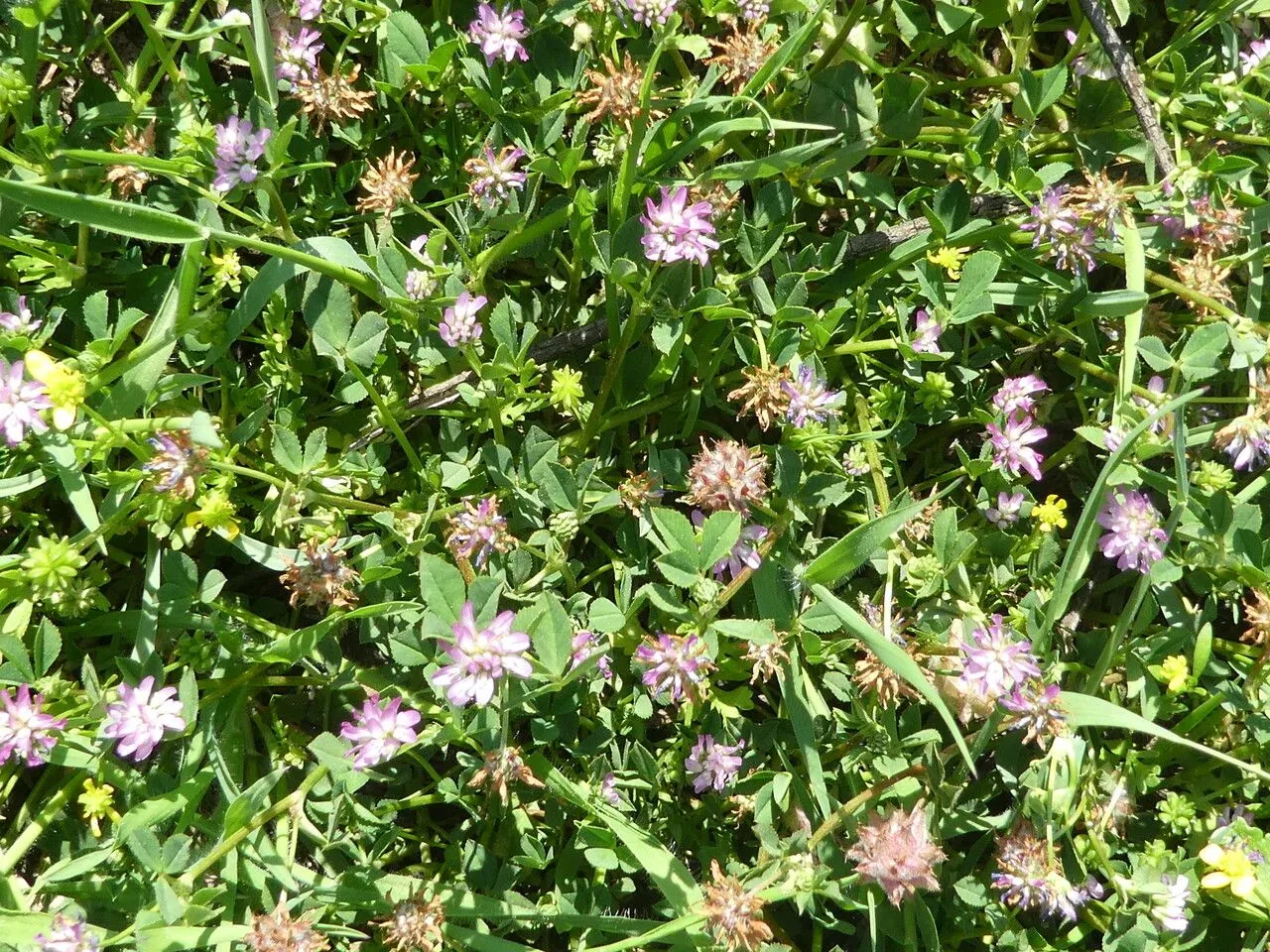
Author: L.
Bibliography: Sp. Pl.: 771 (1753)
Year: 1753
Status: accepted
Rank: species
Genus: Trifolium
Vegetable: False
Observations: Macaronesia, Medit. to W. Nepal
Persian clover, scientifically known as Trifolium resupinatum, is a notable member of the Fabaceae family, recognized for its adaptability and significance in various regions stretching from Macaronesia and the Mediterranean to Western Nepal. This species was first documented in the mid-18th century by the renowned botanist Linnaeus in his work “Species Plantarum,” a crucial publication in the field of botanical nomenclature.
Typically thriving in temperate climates, Persian clover is lauded for its role in sustainable agriculture and ecological contributions. This annual clover is particularly valued as forage, owing to its capacity to fix nitrogen in the soil, thus enhancing fertility and supporting the growth of subsequent crops. It presents a robust solution for pastures, cover cropping, and soil improvement practices.
The plant manifests a sprawling growth habit, with slender stems and trifoliate leaves, characteristic of the clover genus. Its small, purple to pinkish flowers add an aesthetic charm while concurrently providing nectar for pollinators, thus fostering a healthy ecosystem.
Persian clover’s adaptability to a variety of soil types and conditions, including poor soils, makes it a versatile choice for farmers and gardeners alike. It tolerates moderate salinity and can grow in both wet and dry environments, further underlining its resilience.
Cultivating Trifolium resupinatum not only promotes biodiversity but also mitigates erosion and supports sustainable farming practices. Its integration into crop rotations and green manure applications showcases its multipurpose nature, contributing substantially to agricultural efficiency and environmental stewardship.
Eng: annual strawberry clover, bird-eye clover, persian clover, reversed clover, reversed trefoil, shaftal clover, bird’s-eye clover
Deu: gewöhnlicher persischer klee, persischer klee, schabdar, umgewendeter klee
Dan: omvendt kløver
Lit: persinis dobilas
Fra: trèfle de l’écluse, trèfle renversé, trèfle résupiné
Swe: doftklöver, luktklöver
Hun: fonák here
Ces: jetel zvrácený
Por: trevo-da-pérsia
Ita: trifoglio resupinato
Spa: trébol persa
Nld: perzische klaver
Cym: meillionen dinlan, meillionen wrthdro
En: Persian clover, Bird-eye clover, Shaftal clover, Annual strawberry clover, Reversed clover, Reversed trefoil, Bird’s-eye clover
Ar: قداب (قَدَاب)، جدوب (جَدّوب), قرط (قُرط)، جريده (جُريده), قرط (قُرط)، قدب (قَدْب)، قرض (قَرَض), لوينه (لُوَيْنَه)، خنديش (خُنْديش)
Cs: Jetel zvrácený
Da: Omvendt kløver
Nl: Perzische klaver, Omgekeerdbloemige Klaver
Fr: Trèfle renversé, Trèfle de L’Écluse, Trèfle résupiné, Trèfle de Perse, Trèfle Porte-fraises, Trèfle odorant, Trefle De Perse
De: Persischer Klee, Gewöhnlicher Persischer Klee, Schabdar, Umgewendeter Klee, Wildsippe, Kleinblutiger Klee
He: תלתן הפוך
Hu: Fonák here
It: Trifoglio resupinato, Trifoglio risupinato, Trifoglio trafoglino, Trifoglio Persiano
Lt: Persinis dobilas
Pt: Trevo-da-Pérsia, Trevo De Persia
Sk: Ďatelina obrátená
Es: Trébol persa, Trébol de Persia, Trebol Perso
Sv: Doftklöver, Luktklöver
Cy: Meillionen Dinlan, Meillionen Wrthdro
Taken Jun 8, 2019 by Manu Pacha (cc-by-sa)
Taken Jun 16, 2019 by Manu Pacha (cc-by-sa)
Taken Jun 16, 2019 by Manu Pacha (cc-by-sa)
Taken Jun 16, 2019 by Manu Pacha (cc-by-sa)
Taken May 14, 2017 by Tela Botanica − Genevieve BOTTI (cc-by-sa)
Taken May 6, 2021 by Llandrich anna (cc-by-sa)
Taken May 6, 2021 by Llandrich anna (cc-by-sa)
Taken May 6, 2021 by Llandrich anna (cc-by-sa)
Taken May 27, 2020 by Dr. Van Baerle (cc-by-sa)
Taken Apr 19, 2022 by Enimsaj (cc-by-sa)
Taken May 13, 2021 by Daniel Bourget (cc-by-sa)
Taken May 18, 2022 by 1D NRM (cc-by-sa)
Taken May 30, 2022 by Hüseyin mustak (cc-by-sa)
Taken May 6, 2021 by Llandrich anna (cc-by-sa)
Taken Apr 20, 2015 by Tela Botanica − Liliane Roubaudi (cc-by-sa)
Taken Apr 19, 2022 by Monteiro Henrique (cc-by-sa)
Taken Apr 25, 2016 by Tela Botanica − Genevieve BOTTI (cc-by-sa)
Taken May 6, 2021 by Llandrich anna (cc-by-sa)
Taken May 6, 2021 by Llandrich anna (cc-by-sa)
Taken May 13, 2013 by Tela Botanica − Liliane Roubaudi (cc-by-sa)
Taken Jun 10, 2013 by Tela Botanica − Claude FIGUREAU (cc-by-sa)
Taken Jun 10, 2013 by Tela Botanica − Claude FIGUREAU (cc-by-sa)
Taken May 16, 2013 by Tela Botanica − Liliane Roubaudi (cc-by-sa)
Taken Apr 28, 2021 by Leman Leman (cc-by-sa)
Taken Oct 4, 2022 by Nicolas (cc-by-sa)
Taken Apr 15, 2007 by Photoflora – Jean-Luc TASSET (©)
Taken Aug 25, 2019 by Tela Botanica − José Luis Romero Rego (cc-by-sa)
Taken Apr 22, 2015 by Tela Botanica − Paul FABRE (cc-by-sa)
© copyright of the Board of Trustees of the Royal Botanic Gardens, Kew.
© copyright of the Board of Trustees of the Royal Botanic Gardens, Kew.
© copyright of the Board of Trustees of the Royal Botanic Gardens, Kew.
Growth habit: Forb/herb
Ph maximum: 7.0
Ph minimum: 6.5
Light: 8
Atmospheric humidity: 7
Soil nutriments: 7
Soil salinity: 1
Family: Myrtaceae Author: (F.Muell.) K.D.Hill & L.A.S.Johnson Bibliography: Telopea 6: 402 (1995) Year: 1995 Status:…
Family: Rubiaceae Author: Pierre ex A.Froehner Bibliography: Notizbl. Bot. Gart. Berlin-Dahlem 1: 237 (1897) Year:…
Family: Sapindaceae Author: Koidz. Bibliography: J. Coll. Sci. Imp. Univ. Tokyo 32(1): 38 (1911) Year:…
Family: Asteraceae Author: A.Gray Bibliography: Pacif. Railr. Rep.: 107 (1857) Year: 1857 Status: accepted Rank:…
Family: Fabaceae Author: Medik. Bibliography: Vorles. Churpfälz. Phys.-Ökon. Ges. 2: 398 (1787) Year: 1787 Status:…
Family: Aspleniaceae Author: (Cav.) Alston Bibliography: Bull. Misc. Inform. Kew 1932: 309 (1932) Year: 1932…